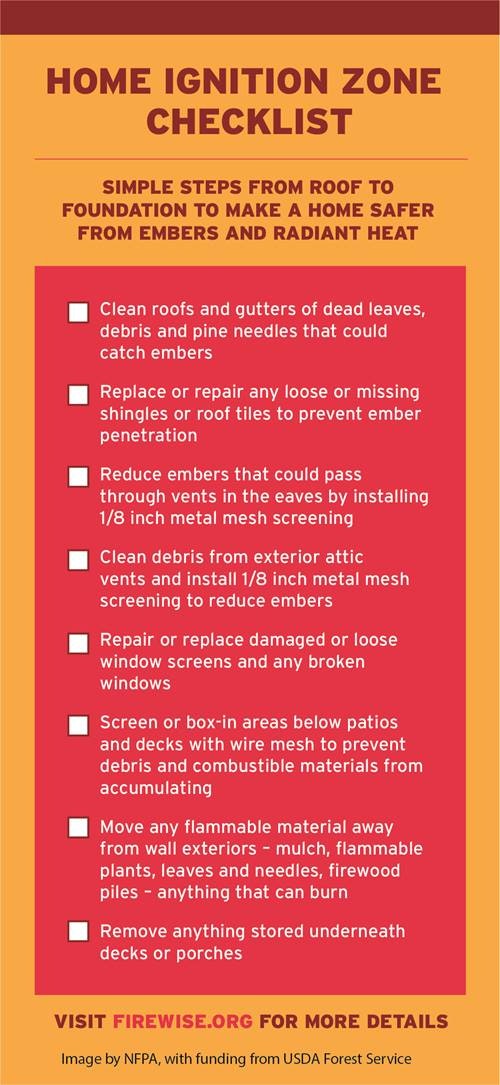Defensible Space
CREATING A DEFENSIBLE SPACE
How to prepare your property to help protect your family and local firefighters.
“Defensible space is essential to improve your home’s chance of surviving a wildfire. It’s the buffer you create between a building on your property and the grass, trees, shrubs, or any wildland area that surround it. This space is needed to slow or stop the spread of wildfire, and it helps protect your home from catching fire—either from direct flame contact or radiant heat. Defensible space is also important for the protection of the firefighters defending your home.” – CalFire

The defensible space should extend to 100’ from your home and included the following:
Immediate zone
The home and the area 0-5’ from the furthest attached exterior point of the home; defined as a non-combustible area. Science tells us this is the most important zone to take immediate action on as it is the most vulnerable to embers. START WITH THE HOUSE ITSELF, then move into the landscaping section of the Immediate Zone.
- Clean roofs and gutters of dead leaves, debris and pine needles that could catch embers.
- Replace or repair any loose or missing shingles or roof tiles to prevent ember penetration.
- Reduce embers that could pass through vents in the eaves by installing 1/8 inch metal mesh screening.
- Repair or replace damaged or loose window screens and any broken windows Screen or box-in areas below patios and decks with wire mesh to prevent debris and combustible materials from accumulating.
- Move any flammable material away from wall exteriors – mulch, flammable plants, leaves and needles, firewood piles – anything that can burn. Remove anything stored underneath decks or porches.
Intermediate zone
5-30’ from the furthest exterior point of the home. Landscaping/hardscaping- employing careful landscaping or creating breaks that can help influence and decrease fire behavior
- Clear vegetation from under large stationary propane tanks.
- Create fuel breaks with driveways, walkways/paths, patios, and decks.
- Keep lawns and native grasses mowed to a height of six inches or less.
- Remove ladder fuels (vegetation under trees) so a surface fire cannot reach the crowns. Prune trees up to six to ten feet from the ground; for shorter trees do not exceed 1/3 of the overall tree height.
- Space trees to have a minimum of fifteen feet between trunks with the distance increasing with the percentage of slope.
- Tree placement should be planned to ensure the mature canopy is no closer than ten feet to the edge of the structure.
- Tree and shrubs in this zone should be limited to small clusters of a few each to break up the continuity of the vegetation across the landscape.
Extended zone
30-100 feet, out to 200 feet. Landscaping – the goal here is not to eliminate fire but to interrupt the fire’s path and keep flames smaller and on the ground.
- Dispose of heavy accumulations of ground litter/debris.
- Remove dead plant and tree material.
- Remove small conifers growing between mature trees.
- Remove vegetation adjacent to storage sheds or other outbuildings within this area.


The information provided in this article is from The National Fire Protection Association and Cal Fire. If you have any questions or would like to schedule a courtesy inspection of your property, please contact us at info@evfire.org.
Thank you and stay safe,
Chief Davidson
Download the Firewise Ignition Zone Checklist below:
Defensible Space brochure.pdfPartnering with the Oregon Defensible Space Foundation
Building Fire-Resilient Communities Through Land Stewardship
The Oregon Defensible Space Foundation (ODS Foundation) is a nonprofit organization dedicated to protecting Oregon’s landscapes and communities through proactive fuel reduction and land management. Based in Rogue River, ODS Foundation collaborates with local partners to implement common-sense, ecologically sound practices that reduce wildfire risk and promote long-term forest health.
How ODS Foundation Supports Our Community
- Fuel Reduction Projects: ODS Foundation leads efforts to clear overgrown vegetation, creating defensible space around homes and neighborhoods. This work is vital in reducing the intensity and spread of wildfires.
- Land Management Education: Through workshops and community outreach, ODS Foundation educates residents on sustainable land stewardship and fire-safe landscaping techniques.
- Collaborative Approach: Working with landowners, fire districts, and environmental groups, ODS Foundation fosters partnerships that balance ecological preservation with fire prevention.
Get Involved
Whether you're a homeowner looking to safeguard your property or a community member eager to contribute, ODS Foundation offers opportunities to participate in creating a fire-resilient environment.
- Volunteer: Join local fuel reduction projects and community clean-up events.
- Donate: Support ongoing initiatives aimed at reducing wildfire risks.
- Learn: Attend educational sessions to better understand defensible space practices.
For more information, visit www.odsfoundation.com or contact Rich Waldo at (916) 425-1255 or RichWaldo@ODSFoundation.com.
